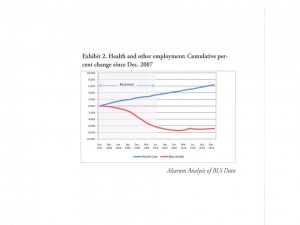 In February 2011, 1 in 10 jobs in the U.S. is in health care employment; nearly 14 million people in the U.S. work in health care employment, with health care representing 10.7% of all jobs in America. The growth rate of health care jobs rose 1.2 percentage points since the recession kicked in late 2007. Since the start of the recession, health employment grew 6.3%; the number of non-health jobs fell by 6.8%. The chart starkly illustrates this story.
In February 2011, 1 in 10 jobs in the U.S. is in health care employment; nearly 14 million people in the U.S. work in health care employment, with health care representing 10.7% of all jobs in America. The growth rate of health care jobs rose 1.2 percentage points since the recession kicked in late 2007. Since the start of the recession, health employment grew 6.3%; the number of non-health jobs fell by 6.8%. The chart starkly illustrates this story.
Altarum Institute has crunched the health job numbers from the Bureau of Labor Statistics (BLS) and published their analysis in Health Sector Economic Indicators, published February 9, 2011. Altarum’s top-line: health care employment has reached an “all-time high” in the U.S.
Outpatient care settings accounted for the fastest-growth in jobs with a 12-month rate of increase of 5.3%. The hospital segment grew the slowest, at a mere 0.7% — basically flat-lining (though still representing, by far, the largest segment in terms of jobs). Home health jobs grew by 4.3%.
Health Populi’s Hot Points: It is impossible to separate the U.S. health microeconomy from the nation’s macroeconomy. With only 39,000 new jobs added to the U.S. economy in January 2011, we economists look for bright signs wherever we can find them. One-third of this increase in total new employment was in health care.
The number of jobs in the health sector will continue to grow. This will continue to be the case for the next decade, at least. Among many drivers for health job growth, two are at the top of the list in 2011: health information technology and the aging of the population. There will be intense demand for workers skilled in health information technology, based on the adoption of electronic health records by providers (both doctors and hospitals), along with growing digitization of all health information generated by digital imaging, point-of-care diagnostics, smart infusion pumps, and other medical devices. Dr. Blackford Middleton of Partners HealthCare projects a need for an additional 40,000 to 160,000 workers in health IT in the coming years.
As for aging, the chart shows already-growing demand for more home care workers. Boomers won’t age quietly into that good night, wishing to avoid institutional care in nursing homes. So home care work will be re-defined back in the person’s home — requiring even more digitally savvy workers to re-imagine and re-design what home care is. This will mean more jobs for new kinds of design and ideation, applying the disciplines of anthropology and sociology, and of course, more IT developers who can marry, say, miniature accelerometers to milk bottles and sensors to scales.
How we define health care jobs today will morph into a new definition for jobs in health tomorrow.




 I'm in amazing company here with other #digitalhealth innovators, thinkers and doers. Thank you to Cristian Cortez Fernandez and Zallud for this recognition; I'm grateful.
I'm in amazing company here with other #digitalhealth innovators, thinkers and doers. Thank you to Cristian Cortez Fernandez and Zallud for this recognition; I'm grateful. Jane was named as a member of the AHIP 2024 Advisory Board, joining some valued colleagues to prepare for the challenges and opportunities facing health plans, systems, and other industry stakeholders.
Jane was named as a member of the AHIP 2024 Advisory Board, joining some valued colleagues to prepare for the challenges and opportunities facing health plans, systems, and other industry stakeholders.  Join Jane at AHIP's annual meeting in Las Vegas: I'll be speaking, moderating a panel, and providing thought leadership on health consumers and bolstering equity, empowerment, and self-care.
Join Jane at AHIP's annual meeting in Las Vegas: I'll be speaking, moderating a panel, and providing thought leadership on health consumers and bolstering equity, empowerment, and self-care.